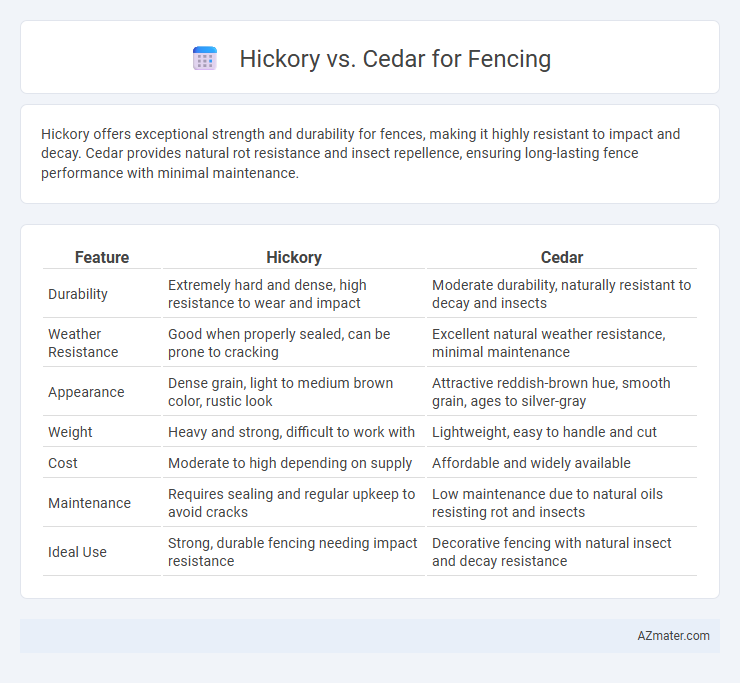Hickory offers exceptional strength and durability for fences, making it highly resistant to impact and decay. Cedar provides natural rot resistance and insect repellence, ensuring long-lasting fence performance with minimal maintenance.
Table of Comparison
| Feature | Hickory | Cedar |
|---|---|---|
| Durability | Extremely hard and dense, high resistance to wear and impact | Moderate durability, naturally resistant to decay and insects |
| Weather Resistance | Good when properly sealed, can be prone to cracking | Excellent natural weather resistance, minimal maintenance |
| Appearance | Dense grain, light to medium brown color, rustic look | Attractive reddish-brown hue, smooth grain, ages to silver-gray |
| Weight | Heavy and strong, difficult to work with | Lightweight, easy to handle and cut |
| Cost | Moderate to high depending on supply | Affordable and widely available |
| Maintenance | Requires sealing and regular upkeep to avoid cracks | Low maintenance due to natural oils resisting rot and insects |
| Ideal Use | Strong, durable fencing needing impact resistance | Decorative fencing with natural insect and decay resistance |
Introduction: Hickory vs Cedar Fencing
Hickory and cedar are popular choices for fencing due to their durability and aesthetic appeal. Hickory offers exceptional strength and shock resistance, making it ideal for heavy-duty fencing, while cedar is prized for its natural resistance to decay and insect damage, ensuring long-lasting beauty. Both woods provide distinct textures and colors that enhance property appeal, but cedar generally requires less maintenance compared to hickory.
Wood Characteristics Overview
Hickory wood is dense and highly durable, offering excellent resistance to wear and impact, making it ideal for sturdy fences requiring long-term strength. Cedar is naturally resistant to decay and insects, with a lightweight and stable grain that minimizes warping and cracking, which enhances its suitability for outdoor fencing. Both woods provide natural weather resistance, but hickory's hardness surpasses cedar's, while cedar offers superior aromatic oils that enhance its protective qualities.
Durability and Longevity Comparison
Hickory fences offer exceptional durability due to their dense hardwood structure, resisting impact and wear better than many alternatives. Cedar, while less dense, provides natural resistance to rot, insects, and weathering, contributing to its longevity in outdoor environments. Over time, cedar fences typically require less maintenance, but hickory's superior hardness grants it a longer lifespan in high-traffic or harsh conditions.
Resistance to Weather and Insects
Hickory fences exhibit strong resistance to weather with excellent durability against moisture and temperature fluctuations, making them suitable for various climates. Cedar fences provide natural resistance to insects and decay due to their aromatic oils, offering long-lasting protection without chemical treatment. While hickory excels in hardness and impact strength, cedar's inherent insect-repellent properties and rot resistance make it a preferred choice for maintaining fence integrity in pest-prone or humid environments.
Maintenance Requirements
Hickory fences demand regular upkeep due to their dense grain structure, requiring periodic sealing and staining to prevent cracking and warping. Cedar fences naturally resist rot and insect damage, minimizing maintenance needs, but still benefit from occasional treatment to maintain color and durability. Both woods require cleaning to remove dirt and mildew, with cedar generally offering a lower-maintenance option for long-term durability.
Aesthetic and Visual Appeal
Hickory fences feature a rich, warm tone with distinctive grain patterns that develop a smooth, elegant patina over time, enhancing curb appeal. Cedar offers a reddish-brown hue with natural knots and a fine, straight grain, providing a rustic yet refined look that resists fading. Both woods bring unique visual charm, with hickory's robust texture contrasting cedar's softer, more uniform appearance.
Environmental Impact and Sustainability
Hickory and cedar differ significantly in environmental impact and sustainability, with cedar being more eco-friendly due to its natural resistance to rot and insects, reducing the need for chemical treatments. Hickory, while durable, often requires more intensive processing and chemical preservatives, which can negatively affect its environmental footprint. Cedar's faster growth rate and better renewability make it a more sustainable choice for fencing materials.
Cost and Value Differences
Hickory fences generally come at a higher initial cost due to the wood's hardness and durability, making it more resistant to dents and wear compared to cedar. Cedar offers a more cost-effective option with natural resistance to rot and insects, providing long-term value through minimal maintenance requirements. Choosing between hickory and cedar for fencing depends on balancing higher upfront investment against lasting durability and aesthetic appeal.
Popular Use Cases and Applications
Hickory fences are popular for their exceptional hardness and durability, making them ideal for high-traffic areas, livestock enclosures, and heavy-duty privacy fences. Cedar is favored for its natural resistance to decay and insect damage, often used in decorative garden fences, residential privacy panels, and ornamental picket fences. Both wood types offer distinct advantages, with hickory suited for strength-demanding applications and cedar preferred for aesthetic appeal and low maintenance.
Final Verdict: Which Wood is Best for Your Fence?
Hickory offers exceptional strength and durability, making it ideal for long-lasting fence structures, while cedar provides natural resistance to decay and insect damage with a more attractive grain and aroma. Cedar requires less maintenance due to its weather-resistant properties, whereas hickory may need additional treatment to prevent rot and insect infestation. For a fence combining aesthetic appeal with low upkeep, cedar is often the best choice, but for maximum toughness and structural integrity, hickory is superior.

Infographic: Hickory vs Cedar for Fence
 azmater.com
azmater.com